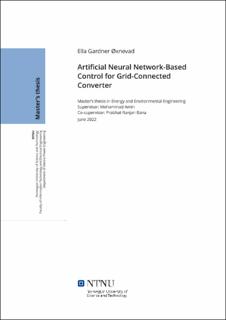| dc.description.abstract | Ettersom andelen fornybare energikilder øker, må kontrollmetodene for nett-tilknyttede omformere forbedres for å sikre stabil og pålitelig drift. I forskning for forbedret omformerkontroll rettes det økende oppmerksomhet mot kunstig intelligens-baserte metoder, og særlig bruken av kunstige nevrale nettverk.
Denne oppgaven undersøker ulike teknologier innen kunstig intelligens for strømregulering av en nett-tilkoblet spenningskildeomformer. Blant disse har fire kunstig nevrale nettverk (ANN)-baserte kontrollmetoder blitt designet og undersøkt. Den første regulatoren består av et feedforward nevralt nettverk som trenes ved bruk av simuleringsdata fra en konvensjonell proporsjonal integral (PI)-regulator, kontrollmetoden omtales PI-ANN-regulator. Tilsvarende består også den andre regulatoren av et FFNN, men i dette tilfellet trenes nettverket ved bruk av data fra en modellprediktiv kontroller (MPC), omtalt som MPC-ANN regulator. Den tredje regulatoren består av et tilbakevendende (recurrent) nevralt nettverk (RNN) som trenes ved hjelp av dynamisk programmering som tilnærmer optimal kontroll. Kontrollmetoden omtales som RNN-basert regulator. Den fjerde og siste regulatoren består av to feedforward nevrale nettverk som trenes ved hjelp av direkte heuristisk dynamisk programmering (dHDP).
Ytelsen til PI-ANN-, MPC-ANN- og dHDP-regulatorene er blitt evaluert og sammenlignet ved hjelp av simuleringsresultater hentet fra Matlab/Simulink-simuleringsmiljøet. Mens PI-ANN-kontrolleren ikke viser noen forbedring sammenlignet med den konvensjonelle PI-kontrolleren, yter MPC-ANN og dHDP betydelig bedre, og oppnår mindre oscillasjoner, forbedret dynamisk respons og robusthet mot parameterendringer. Ytelsen til PI-ANN og MPC-ANN-regulatorene har blitt verifisert ved å sammenligne simuleringsresultatene fra Matlab/Simulink med resultater fra OPAL-RT. | |
| dc.description.abstract | As the share of renewable energy sources increases, the control methods for grid-connected converters need to be improved to ensure stable and reliable operation. New control methods are replacing conventional proportional plus integral control as they have been shown to be faster, more robust, and more accurate. Among numerous control methods, the use of artificial intelligence, and more specifically the use of artificial neural networks is increasingly drawing attention in research for improved converter control.
This thesis investigates various artificial intelligence technologies for the inner current control for the grid-connected voltage source converter. Amongst these, four different artificial neural network (ANN)-based control methods are designed and investigated. The first controller consists of a feedforward neural network which is trained using simulation data from a conventional PI controller, which is referred to as PI-ANN control. Similarly, the second controller is also based on the feedforward neural network, but in this case it is trained using data from a model predictive controller (MPC-ANN controller). The third controller consists of a recurrent neural network (RNN) which is trained using dynamic programming approximating optimal control, this is referred to as RNN-based control. The fourth and last controller consists of two feedforward neural networks which are trained using direct heuristic dynamic programming (dHDP).
While the RNN-controller needs further improvements to complete the implementation, the other three controllers are fully developed and implemented in the Matlab/Simulink simulation environment. The performance of the PI-ANN, MPC-ANN and dHDP controllers is evaluated and compared, using simulation results obtained from Matlab/Simulink. Whilst the PI-ANN controller shows no improvement compared to the conventional PI controller, the MPC-ANN and the dHDP perform significantly better with less oscillations, improved dynamic response, and robustness against parameter changes. In addition, the performance of the PI, PI-ANN, MPC and the MPC-ANN controllers has been validated through comparison with OPAL RT hardware-in-the-loop simulations. | |
